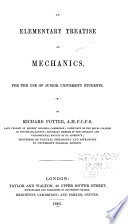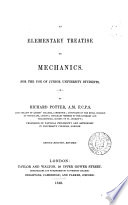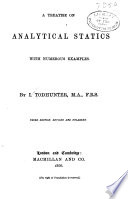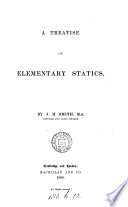 | Richard Potter - Mechanics - 1846 - 190 pages
...the point of appliPQ cation of their resultant = ' AB&m. 0. -i ~T~ *o£ 4. If three forces which act at a point be represented in direction and magnitude...the sides of a triangle taken in order, they will make equilibrium ; shew that if, instead of acting at one point, they each act in the line which is... | |
 | Richard Potter - 1848 - 196 pages
...about the point of appliPQ cation of their resultant = —^—AB sin. 9. 4. If three forces which act at a point be represented in direction and magnitude...the sides of a triangle taken in order, they will make equilibrium ; shew that if, instead of acting at one point, they each act in the line which is... | |
 | Augustus William Smith - Mechanics, Analytic - 1855 - 368 pages
...the triangle, taken in order, will represent the forces. Conversely, if the forces can be represented by the sides of a triangle, taken in order, they will be in equilibrium. Let the forces P, Q, and R be in equilibrium, and be represented by AB, AD, and AE respectively. Produce... | |
 | Augustus William Smith - Mechanics, Analytic - 1855 - 340 pages
...the triangle, taken in order, will represent the forces. Conversely, if the forces can be represented by the sides of a triangle, taken in order, they will be in equilibrium. Let the forces P, Q, and R be in equilibrium, and be repreB sented by AB, AD, and AE respectively.... | |
 | Stephen Parkinson - Dynamics - 1863 - 396 pages
...The Triangle of Forces. If three forces acting at a point be represented in magnitude and direction by the sides of a triangle taken in order, they will be in equilibrium. Let ABC be the triangle whose sides taken in order represent in direction and magnitude three forces... | |
 | Augustus William Smith - Mechanics, Analytic - 1863 - 340 pages
...the triangle, taken in order, will represent the forces. Conversely, if the forces can be represented by the sides of a triangle, taken in order, they will be in equilibrium. Let the forces P, Q, and R be in equilibrium, and be repre sented by AB, AD, and AE respectively. Produce... | |
 | Thomas Lund - Hydrostatics - 1864 - 188 pages
...Balance, (in which the weight (P) is always the same), and shew how to graduate it. 3. If three forces, represented in direction and magnitude by the sides of a triangle taken in order, act on a point, they will produce equilibrium. Two forces, whose magnitudes are «/3xP, and P, respectively... | |
 | Thomas Lund - Hydrostatics - 1864 - 204 pages
...Balance, (in which the weight (P) is always the same), and shew how to graduate it. 3. If three forces, represented in direction and magnitude by the sides of a triangle taken in order, act on a point, they will produce equilibrium. Two forces, whose magnitudes are «/3xP, and P, respectively... | |
 | Isaac Todhunter - Mathematics - 1866 - 386 pages
...AG, AH represents the resultant of the two forces which AG and AH respectively represent. 17. // two forces acting at a point be represented in direction and magnitude by two straight lines drawn from, the point, and a parallelogram be described on these straight lines... | |
 | James Hamblin Smith - Statics - 1868 - 102 pages
...TRIANGLE OF FORCES. If three forces acting at a point can be represented in magnitude and direction by the sides of a triangle taken in order, they will be in equilibrium. Let AB, BC, CA, the sides of the triangle ABC taken in order, represent in magnitude and direction... | |
| |